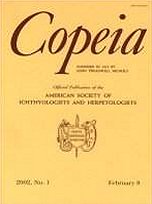Variation in mitochondrial DNA (mtDNA) was assessed in a captive stock and 11 wild populations (n = 259) from throughout the native range of Desert Pupfish Cyprinodon macularius as traditionally understood. Using PCR-SSCP, 18 composite haplotypes were identified from a 333-bp segment of the mitochondrial D-loop and two segments of the ND2 gene (333 and 325 bp). Representatives of each haplotype were sequenced for the entire ND2 gene and the 337-bp segment of the D-loop. Phylogenetic analyses revealed that haplotypes form two monophyletic groups, one in the Río Sonoyta/Quitobaquito Springs area and one in the Salton Sea/Colorado River Delta. This, with previous observations on morphology, color pattern, and geological history, supports recognition of the Río Sonoyta/Quitobaquito populations as a separate species, the Quitobaquito Pupfish C. eremus Miller and Fuiman, from the more widespread desert pupfish C. macularius Baird and Girard. More than 70% of mtDNA diversity across all populations was attributable to differences between the two species. Within species, the average local population contains 94% and 97% of the diversity in, respectively, C. eremus and C. macularius. Differences between the Salton Sea and Colorado River Delta populations of C. macularius explain a small (3.7%), but statistically significant, portion of mtDNA diversity in this species. This and the history of connections between Salton Sea and the delta suggest that the two regions should be managed separately with no intermixing of pupfish other than what occurs when the present, human-regulated hydrology is overcome by natural flooding. Haplotype frequencies in C. eremus from Quitobaquito Springs and Río Sonoyta were not significantly different. However, the potentially long history of isolation between these two populations and evidence of some degree of morphological divergence indicate a need for conservative management with no intermixing. The captive stock exhibited reduced mtDNA variation relative to its wild parent population from a locality on the delta.
Variación de ADNmt fue examinado por una cepa de cautivo y 11 poblaciones silvestres (n = 259) de todas partes del rango natural del cachorrito del desierto Cyprinodon macularius como entendido tradicionalmente. Utilizando PCR-SSCP, 18 haplotipos compuestos fueron identificados desde un segmento de 337-pb del D-loop mitocondrial y dos segmentos del gene DN2 (333 pb y 325 pb). Representantes de cada haplotipo fueron sequenciados por el gene DN2 entero y el segmento de 337-pb del D-loop. Análisis filogenético mostró una relación monofilética reciproca entre poblaciones de dos regiones generales, Río Sonoyta/Quitobaquito y Salton Sea/Delta del Río Colorado. Esto, con observaciones previas de morfología, patrón de color, y la história geológica, sostiene el reconocimiento de las poblaciones de Río Sonoyta/Quitobaquito como una especie distinta, el cachorrito de Quitobaquito C. eremus Miller and Fuiman, de la especie con una distribución más amplia, el cachorrito del desierto C. macularius Baird and Girard. Más de 70% de la diversidad ADNmt de todas las poblaciones fue atribuida a diferencias entre las dos especies. Dentro de cada especie, la población promedia local contiene 94% y 97% de la diversidad de, respectivamente, C. eremus y C. macularius. Las diferencias entre las poblaciones de C. macularius del Salton Sea y las de la Delta del Río Colorado explican una pequeña (3.7%) pero una porción estadísticamente significativa de la diversidad ADNmt de esta especie. Esto y la historia de conecciones entre el Salton Sea y la delta sugieren que los dos regiones deben ser manejadas aparte sin mezclar a los cachorritos más que lo que ya ocurre cuando la hidrología actual controlada por los humanos, está conquistada por inundaciones naturales. Frequencias de los haplotip





